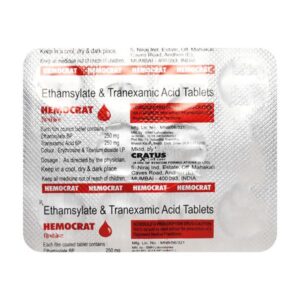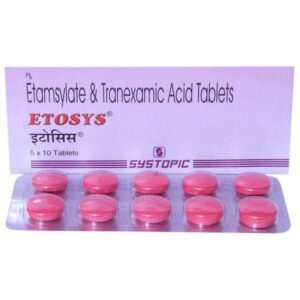ETHAMSYLATE + TRANEXAMIC ACID
Ethamsylate: Ethamsylate is a medication that is used for the treatment of bleeding disorders, particularly those caused by increased fragility of blood vessels. It is commonly prescribed for conditions such as menorrhagia (excessive menstrual bleeding), nosebleeds, abnormal bleeding after surgery or injury, and bleeding associated with certain medical conditions such as cirrhosis or gastric ulcers.
The exact mechanism of action of ethamsylate is not fully understood. However, it is believed to work by promoting the formation of platelet plug and increasing platelet adhesiveness, thereby helping to stop bleeding. It may also strengthen the walls of blood vessels, making them less prone to rupture.
The standard dose of ethamsylate varies depending on the age, weight, and condition being treated. Typically, it is taken orally in tablet form, with the recommended dose ranging from 250 mg to 500 mg three times daily. The duration of treatment is usually determined by the underlying cause of bleeding and the response to therapy.
Like any medication, ethamsylate can have side effects. Common side effects include nausea, stomach pain, diarrhea, headache, dizziness, and skin rashes. These side effects are usually mild and temporary. In rare cases, more severe side effects such as allergic reactions, blood disorders, and liver problems may occur. It is important to consult a healthcare professional if any unusual or severe side effects are experienced.
It is worth noting that ethamsylate should not be used in individuals with a known hypersensitivity to the drug, those with a history of blood clots, or those with severe kidney or liver disease. It is also not recommended for use in pregnant or breastfeeding women unless specifically prescribed by a doctor.
Overall, ethamsylate is an effective medication for managing bleeding disorders and can help alleviate the symptoms associated with excessive bleeding. However, it is important to use it under the guidance of a healthcare professional and follow the prescribed dose to minimize the risk of side effects.
Tranexamic Acid: Tranexamic Acid is a medication commonly used to control or prevent excessive bleeding. It belongs to a class of drugs called antifibrinolytics, which work by preventing the breakdown of blood clots and reducing bleeding.
Tranexamic Acid is often used in situations where there is a risk of severe bleeding, such as during surgery, dental procedures, heavy menstrual bleeding, nosebleeds, or in individuals with certain bleeding disorders. It can also be used to treat bleeding in conditions like hemophilia or von Willebrand disease.
The exact mechanism of action of Tranexamic Acid involves blocking the activity of plasmin, an enzyme that breaks down blood clots. By inhibiting plasmin, Tranexamic Acid promotes clot stability, thereby reducing bleeding.
The typical recommended dose of Tranexamic Acid varies depending on the condition being treated. For most situations, the usual oral dose is 1-1.5 grams taken 2-3 times per day. For heavy menstrual bleeding, the starting dose is usually 1 gram taken 3 times per day during the periods, for up to 5 days.
Like any medication, Tranexamic Acid can have side effects. Common side effects may include gastrointestinal discomfort like nausea, vomiting, diarrhea, or stomach cramps. Rare but serious side effects can include blood clots, visual disturbances, or allergic reactions. It is important to seek medical attention if any severe side effects occur.
Tranexamic Acid should not be used in individuals with a history of blood clots, kidney disease, or certain eye conditions. It may interact with other medications, so it is important to inform your healthcare provider about all the medications you are taking before starting Tranexamic Acid.
Overall, Tranexamic Acid is an effective medication for managing excessive bleeding, but its use should be supervised by a healthcare professional who can determine the appropriate dose and monitor for any potential side effects.


